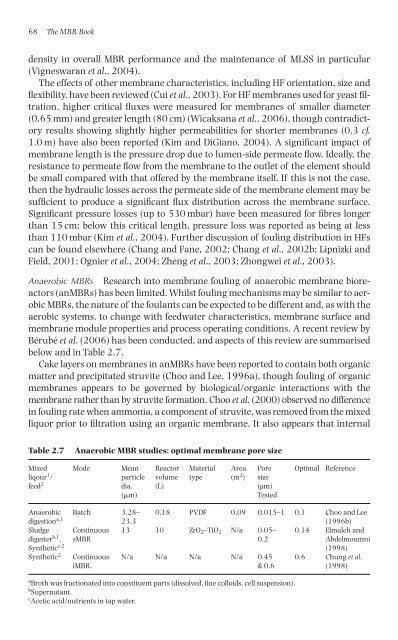The MBR Book: Principles and Applications of Membrane
The MBR Book: Principles and Applications of Membrane
The MBR Book: Principles and Applications of Membrane
Create successful ePaper yourself
Turn your PDF publications into a flip-book with our unique Google optimized e-Paper software.
68 <strong>The</strong> <strong>MBR</strong> <strong>Book</strong><br />
density in overall <strong>MBR</strong> performance <strong>and</strong> the maintenance <strong>of</strong> MLSS in particular<br />
(Vigneswaran et al., 2004).<br />
<strong>The</strong> effects <strong>of</strong> other membrane characteristics, including HF orientation, size <strong>and</strong><br />
flexibility, have been reviewed (Cui et al., 2003). For HF membranes used for yeast filtration,<br />
higher critical fluxes were measured for membranes <strong>of</strong> smaller diameter<br />
(0.65 mm) <strong>and</strong> greater length (80 cm) (Wicaksana et al., 2006), though contradictory<br />
results showing slightly higher permeabilities for shorter membranes (0.3 cf.<br />
1.0 m) have also been reported (Kim <strong>and</strong> DiGiano, 2004). A significant impact <strong>of</strong><br />
membrane length is the pressure drop due to lumen-side permeate flow. Ideally, the<br />
resistance to permeate flow from the membrane to the outlet <strong>of</strong> the element should<br />
be small compared with that <strong>of</strong>fered by the membrane itself. If this is not the case,<br />
then the hydraulic losses across the permeate side <strong>of</strong> the membrane element may be<br />
sufficient to produce a significant flux distribution across the membrane surface.<br />
Significant pressure losses (up to 530 mbar) have been measured for fibres longer<br />
than 15 cm; below this critical length, pressure loss was reported as being at less<br />
than 110 mbar (Kim et al., 2004). Further discussion <strong>of</strong> fouling distribution in HFs<br />
can be found elsewhere (Chang <strong>and</strong> Fane, 2002; Chang et al., 2002b; Lipnizki <strong>and</strong><br />
Field, 2001; Ognier et al., 2004; Zheng et al., 2003; Zhongwei et al., 2003).<br />
Anaerobic <strong>MBR</strong>s Research into membrane fouling <strong>of</strong> anaerobic membrane bioreactors<br />
(an<strong>MBR</strong>s) has been limited. Whilst fouling mechanisms may be similar to aerobic<br />
<strong>MBR</strong>s, the nature <strong>of</strong> the foulants can be expected to be different <strong>and</strong>, as with the<br />
aerobic systems, to change with feedwater characteristics, membrane surface <strong>and</strong><br />
membrane module properties <strong>and</strong> process operating conditions. A recent review by<br />
Bérubé et al. (2006) has been conducted, <strong>and</strong> aspects <strong>of</strong> this review are summarised<br />
below <strong>and</strong> in Table 2.7.<br />
Cake layers on membranes in an<strong>MBR</strong>s have been reported to contain both organic<br />
matter <strong>and</strong> precipitated struvite (Choo <strong>and</strong> Lee, 1996a), though fouling <strong>of</strong> organic<br />
membranes appears to be governed by biological/organic interactions with the<br />
membrane rather than by struvite formation. Choo et al. (2000) observed no difference<br />
in fouling rate when ammonia, a component <strong>of</strong> struvite, was removed from the mixed<br />
liquor prior to filtration using an organic membrane. It also appears that internal<br />
Table 2.7 Anaerobic <strong>MBR</strong> studies: optimal membrane pore size<br />
Mixed Mode Mean Reactor Material Area Pore Optimal Reference<br />
liqour 1 / particle volume type (m 2 ) size<br />
feed 2 dia. (L) (µm)<br />
(�m) Tested<br />
Anaerobic Batch 3.28– 0.18 PVDF 0.09 0.015–1 0.1 Choo <strong>and</strong> Lee<br />
digestion a,1 23.3 (1996b)<br />
Sludge Continuous 13 10 ZrO 2–TiO 2 N/a 0.05– 0.14 Elmaleh <strong>and</strong><br />
digester b,1 , s<strong>MBR</strong> 0.2 Abdelmoumni<br />
Synthetic c,2 (1998)<br />
Synthetic 2 Continuous N/a N/a N/a N/a 0.45 0.6 Chung et al.<br />
i<strong>MBR</strong>. & 0.6 (1998)<br />
aBroth was fractionated into constituent parts (dissolved, fine colloids, cell suspension).<br />
bSupernatant. cAcetic acid/nutrients in tap water.



